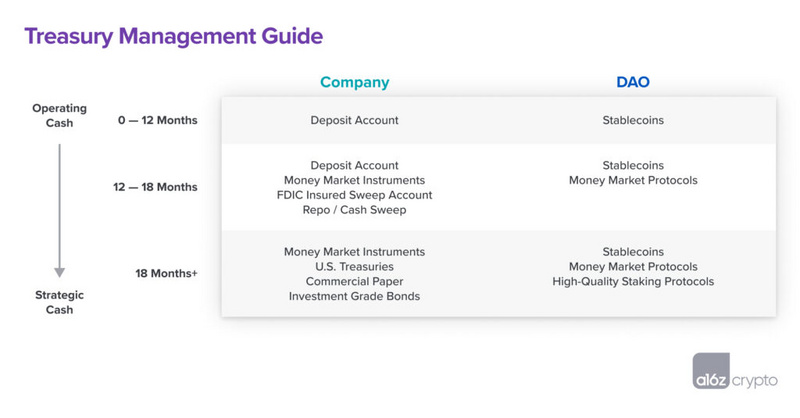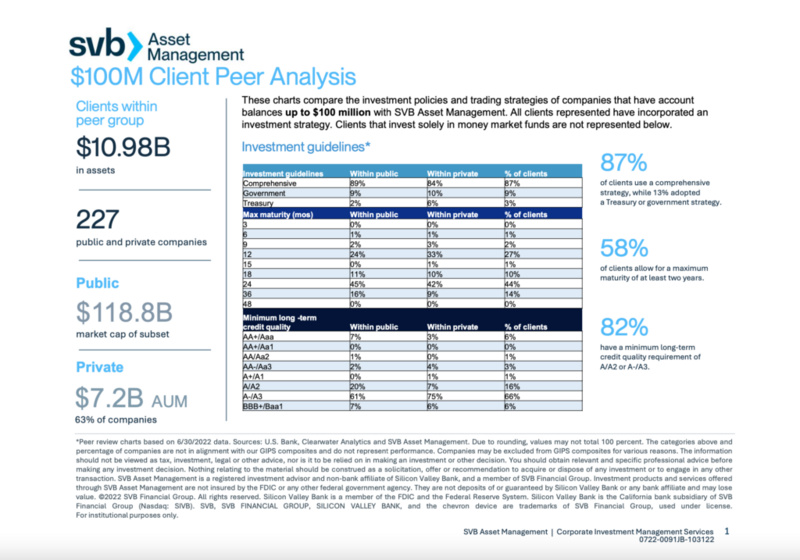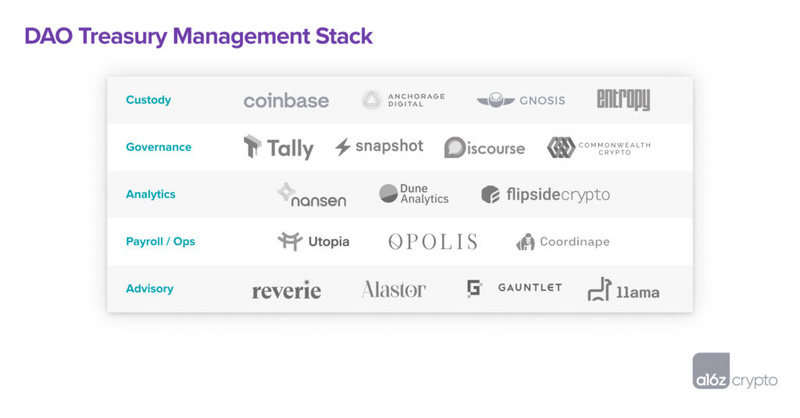a16z: A Guide to Financial Management of Funds in a Bear Market
Written by: Jeff Amico & Maggie Hsu & Ed Lynch & Emily Westerhold, a16z
Compiled by: Katie Gu, Odaily Planet Daily
The cryptocurrency market is volatile. Over the past year, prices have fluctuated dramatically, only recently rebounding from an active "winter."
Treasury management is the way project teams manage resources to ensure the business can operate sustainably and has enough operational cash on hand. This may involve short-term expenses such as paying salaries and rent, or long-term strategic investments such as acquisitions and R&D. Regardless of the amount spent, Treasury management is a priority, focusing on achieving the project's core operational goals.
Treasury management is a core function for any organization, but given the current uncertainty in the market, holding onto cash and making each move carefully is especially important. From DAOs to traditional startups, teams are facing a tightening market environment characterized by high inflation, low yields, and reduced financing options in both public and private markets. In this "new normal," teams should emphasize conservative Treasury management principles to safely weather the winter and emerge stronger when the next wave arrives.
Here, we strongly recommend the following five points from the basic framework of Treasury management that teams should follow.
1. Calculate Monthly Cash Burn
The first step is to establish a realistic financial model. This involves tracking expected monthly cash inflows and outflows (e.g., "net burn"). Calculate the expected monthly expenses for a given project and analyze the components driving revenue and expenses. For example, the expense side should list expenditures across key operational functions (engineering, business development, legal, etc.), as well as any anticipated non-operational outflows (financing costs, taxes, other one-time payments, etc.). Revenue should also categorize inflows into operational and non-operational types. This will help determine their relative predictability over time.
Conservative assumptions will help ensure that the project does not veer off course due to overestimation. This is especially true when forecasting revenues. During bear markets, revenue may decline as clients cut budgets (or go bankrupt), or growth may slow. Even assuming revenue is stable or contractually guaranteed, it may still be difficult to reach the projected amounts. This financial planning does not always apply to unprofitable crypto projects and early-stage ventures, but incorporating these possibilities can help projects plan realistically for the long term.
DAOs differ significantly from traditional startups, including their organizational structure and the degree of decentralized control. As DAOs continue to evolve and adopt more complex operational structures, predicting their overall financial health becomes crucial. This will ensure they can cover operational costs, including payments, incentive programs, and more. It will also add transparency to the operational status of the DAO, aiding better decision-making.
2. Maintain Operational Expenses with Cash
Once the cash burn rate is determined, the project can begin to formulate an overall Treasury management plan. The core objectives are: capital preservation, liquidity, and yield.
The first priority is to cover near-term operational expenses. Before exploring opportunities to generate revenue, optimizing the safety and availability of funds is key. This typically means maintaining at least 12 months (ideally 18 months) of operational expenses in basic cash accounts (e.g., bank deposits or money market accounts), or in the case of a DAO, in high-quality stablecoins. These funds will yield relatively small returns but can be used to repay short-term debts when they come due, which is a conservative choice.
In addition to maintaining short-term cash expenditures, projects should ensure currency matching of assets and liabilities. That is, if liabilities are denominated in USD, then the corresponding liquid assets should also be denominated in USD. This is particularly important for companies or DAOs that hold crypto assets but incur expenses in USD. To avoid having to sell depreciated assets during market downturns, teams should ensure they regularly convert assets into the appropriate currency to cover ongoing operational expenses. Of course, they must also ensure that any asset sales comply with regulatory restrictions and follow relevant laws and tax obligations.
Asset diversification is relatively rare. A recent study by Chainalysis found that 85% of DAOs store all their assets in a single crypto asset (usually the native governance token). Among those holding stablecoins, most hold stablecoins that account for 10% or less of their reserves. While some DAOs may have limited operational expenses, those with substantial operations may be forced to sell their native tokens at a loss to cover operational costs or cut core strategic plans. This is not an optimal solution.
Some projects may be reluctant to sell cryptocurrencies for fiat or stablecoins due to concerns that this would send a "bearish signal" to the market. Projects can avoid negative outcomes by maintaining a sufficient cash buffer. For example, selling native tokens in a declining market or cutting strategic initiatives. Proper cash management can ensure that projects can cover potentially long-term expenses, which is crucial during bear markets when financing markets may face challenges. Planning ahead can also keep projects focused on core operational goals and aware of their operational funding gains and losses.
3. Develop a Plan for Additional Funding
For companies holding cash that exceeds 12-18 months of operating budget, there is more initiative to explore opportunities for increased yield, which should be adjusted based on the project's liquidity needs. The chart below provides a high-level view of various products and when they may be appropriate to consider. Generally, when a project shifts from operational cash (for day-to-day needs) to strategic cash (for pursuing growth and other opportunities), products that offer higher yields become more suitable.

Each product has different risks, yields, and liquidity. A basic plan needs to be established before allocating them.
We often share an investment plan template with traditional portfolio companies. While some of these considerations may not apply to early-stage companies, DAOs, and other projects, they provide guidance on how larger companies think about cash management.
In general, traditional companies invest excess cash in safe assets. These products include money market instruments and investment-grade fixed-income securities (rated 3B or higher). In a given portfolio, these companies typically diversify assets across different maturities, credit qualities, industries, and issuers. Below is the allocation for mid-to-late stage companies with assets not exceeding $100 million at Silicon Valley Bank.

While we have seen some company Treasuries take on additional risk in recent years, a more conservative strategy is often still wise. This is especially true in the current interest rate environment, where yields on many traditional credit and banking products are beginning to rise. Portfolios centered around these types of assets may be very suitable for many companies.
At the same time, various money market and fixed-income products have emerged in recent years for DAOs managing on-chain Treasuries, which should be considered appropriately. These products include Compound, Element Finance, and Goldfinch. In the long term, investing in high-quality protocols like Lido is a good choice. However, as with traditional products, it is important to consider the risks, yields, and liquidity of these options before allocating them. When interacting with on-chain assets or protocols, it is also crucial to assess any potential technical or operational risks to ensure that projects do not expose their assets to loss risks.
4. Strengthen Operational Capabilities
Once strategies are determined, it’s time to implement them. For companies with more traditional Treasury management plans, it is necessary to seek banking partners and investment advisors and establish internal processes to ensure compliance with appropriate custodial, reporting, valuation, control, tax, and audit requirements.
Projects do not need to "do it all themselves." Banking partners can help provide investment tools that align with the company's investment policy. Banking partners can also recommend more established investment advisors to help maximize returns within specific risk parameters. For procedures related to investment and yield accounting, it is essential to consult with accounting firms or auditors.
For DAOs or companies holding cryptocurrencies, the following diagram lists some operational priorities:

Setting up secure wallets is necessary to ensure that assets are always safely held. This is particularly important when assets are deployed to other protocols or otherwise moved on-chain. Options range from traditional custodians like Anchorage or Coinbase to decentralized or multi-signature options like Entropy or Gnosis.
In addition to custody, DAOs typically need some form of governance approval from token holders before executing funding management strategies. Tools like Snapshot and Tally can be used for voting, while forums like Discourse and Commonwealth can facilitate community discussions.
DAOs can also leverage emerging on-chain analytics product suites to monitor the long-term status of their strategies, including Nansen, Dune, and Flipside Crypto. Compensation and operational-related tools like Opolis, Coordinape, and Utopia can also be used to manage budgets and track long-term expenditures.
Finally, consulting relevant companies is advisable. These include traditional advisory firms like Silicon Valley Bank, as well as local crypto companies like Reverie, Alastor, Gauntlet, and Llama. Teams should also ensure that various strategies undergo regulatory analysis and hire external consultants as needed.
5. Monitor and Make Necessary Adjustments
Finally, teams should actively monitor their cash situation and adjust strategies as needed. This requires updating expenditure forecasts to ensure cash is managed properly. Teams should also regularly confirm that their strategies still revolve around core principles (capital preservation, liquidity, yield). This will ensure they do not take on unnecessary risks.
Conclusion
Treasury management is a component of any project's long-term success. To maximize the chances of success, cash management and long-term capital allocation should be clearly defined and properly executed.
In the current economic conditions, it is important to critically consider potential additional business expenses that may arise outside of normal operating processes. Once a project has a conservative estimate of the capital needed to maintain operations, it should reserve an available cash balance equivalent to at least 12 months (preferably 18 months) of net cash outflows. Any remaining cash reserves can then be allocated according to strategy. After formulating a strategy, the performance of held assets should be monitored, and the applicability of the strategy should be regularly assessed to match the project's evolving needs.










